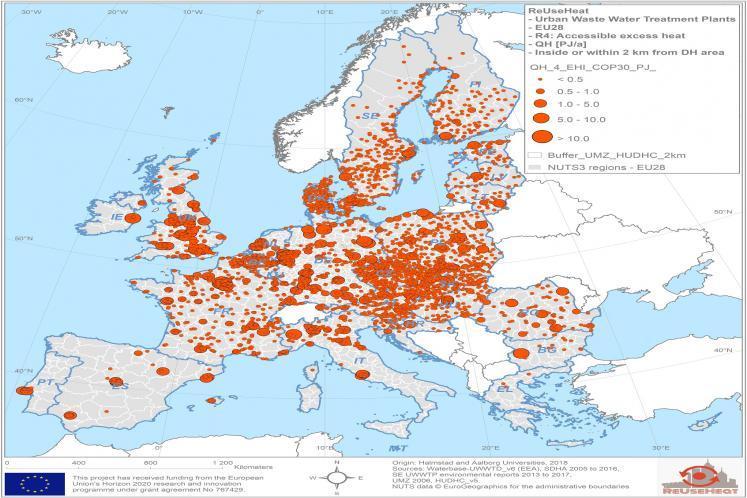ReUseHeat quantified EU28 urban waste heat potential

The ReUseHeat report "Accessible Urban Waste Heat" shows a significant heat recovery potential from unconventional excess heat sources. Approximately 1.2 EJ (or 340 TWh) per year are possible to recover from data centres, metro stations, service sector buildings, and waste water treatment plants. This corresponds to more than 10 percent of the EU's total energy demand for heat and hot water, which is approximately 10.7 EJ (or 2,980 TWh).
Urban Persson, Assistant Professor in Energy Technology at Halmstad University, is convinced that an increased use of waste heat can contribute to the closure of coal-fired power plants: “It is important to reduce the primary energy demand, which is good not only from a climate perspective. It is also a matter of using the resources of the society wisely. If we use the energy more than once, we have succeeded!”
Urban Persson and his colleague Helge Averfalk have estimated the EU28 waste heat potential that can be recovered from urban facilities located inside or within 2 kilometres of current district heating areas. The report focuses on the recovery of low-temperature excess heat, e.g. heat below 50°C, unlike industrial waste heat, which usually has a higher temperature.
The main conclusion is that the potential for heat recovery is particularly important in waste water treatment plants. “Such recycling is already taking place to a large extent in Swedish district heating networks. The rest of the EU also has good opportunities to use more of this heat”, says Urban Persson.
Read more in the report Accessible Urban Waste Heat: https://www.reuseheat.eu/wp-content/uploads/2019/02/D1.4-Accessible-urban-waste-heat.pdf
Large-scale heat pumps and extended district heating networks are required for the low-temperature waste heat to be usable. In countries with predominantly individual heating systems, running on electricity or gas, it may require additional investments in infrastructure. For this reason, the project also has a great focus on overcoming non-technical barriers for unlocking urban waste heat recovery projects and investments across Europe.
The ReUseHeat project (www.reuseheat.eu) runs until 2021 and, among other things, performs four large-scale demonstration projects on excess heat recovery and reuse at four locations in the EU: a water treatment plant in Nice, a metro station in Berlin, a cooling system of a hospital in Madrid and a data centre in Brunswick. The experience from running the demonstrators and from other examples across the EU will be consolidated into a handbook that will provide guidance for investors and project developers and support future uptake of using urban excess heat.
Four other important project reports have been recently produced:
-Energy planning analysis on future energy system in the demo countries:
https://www.reuseheat.eu/wp-content/uploads/2019/03/D1.5-Energy-planning-analysis.pdf
-Market and stakeholder analysis:
https://www.reuseheat.eu/wp-content/uploads/2019/03/D2.1-Market-and-stakeholder-analysis.pdf
-Risk assessment and suitable ownership and funding models for urban waste heat recovery investments:
https://www.reuseheat.eu/wp-content/uploads/2019/03/D2.5-Risk-assessment.pdf
-Scalability, replicability and modularity of the ReUseHeat demonstrators:
More results from the project, namely on bankability and contractual forms, are expected during the summer.
News published on Build Up News
Consult the source



